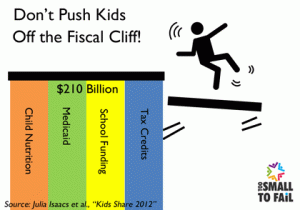By now, most people who pay attention to the news have heard about the “fiscal cliff.” The problem: Most people don’t know what the fiscal cliff actually is, or how it will impact their families.
The term “fiscal cliff” is shorthand for a series of events that will occur at the end of 2012 that will impact how the federal government operates. These include automatic, across-the-board cuts to funds for schools with low-income and special needs students; increases in income taxes and the payroll tax, which fall primarily on middle-income families; decreases in tax credits to support working families and children; and the expiration of unemployment insurance benefits that help those experiencing long-term unemployment, including aid to many of the parents of the 6.2 million children who are living with unemployed parents.
How did we get here? It’s easy to forget that the way our government collects and spends its revenue is largely a statement about our values and priorities as a country. For example, the federal government invests $25,455 for every senior compared to $3,822 for every child. This doesn’t suggest that seniors shouldn’t be a priority–in fact, programs such as Social Security and Medicare have dramatically reduced poverty among seniors.
But it does beg the question: For a nation that claims to care about our kids, we’re not exactly putting our money where our values are. And the investments we are making–ensuring that all children have access to health insurance, that they won’t go hungry when their parents are out of work, and that our neediest children receive the federal aid they need to get a good education–are all at risk in the debate about the fiscal cliff.
The bottom line for parents should be that we won’t stand for cuts that pull the rug out from under our kids.
How We Got Here
The fiscal cliff is the result of an ongoing debate in Washington about how much debt the United States should carry, which revenue and spending policies will best help the economy grow, and whether the United States can sustain the level of commitments it has made to America’s seniors through Social Security and Medicare.
Leaders from both parties agree that the United States should reduce its debt and figure out how to reduce the growth in spending on Social Security and Medicare; to achieve these objectives, Congress passed a law in 2011 that requires execution of an agreement to control deficit spending–or face automatic cuts to the federal budget. That agreement never materialized, so as of January 1, 2013, the country will face $1.2 trillion dollars in automatic cuts to the federal budget. At the same time, a number of reductions to income and payroll taxes will expire. Mix them all together, and you have the fiscal cliff.
The Impact on Children and Families
When Congress agreed to automatically cut spending, they also agreed that there were some programs that were too important to cut. Among them are the programs that provide the most federal aid to children:
- Medicaid and the Children’s Health Insurance Program (CHIP), which provide health insurance to about 40 percent of the children who have coverage
- The Supplemental Nutrition Assistance Program (SNAP, formerly called food stamps); half of all SNAP recipients are kids
- Social Security, which provides critical income assistance to children in families where a major breadwinner has died or is unable to work due to disability
The bad news: All of these programs are now being discussed as potentially back on the chopping block.
In addition, there are many federal investments that positively impact children’s lives that are not protected, and will automatically be cut–among them the $1.1 billion in funding for Title I schools, which are the schools with the most low-income children, and $903 million in federal funding that goes to states to help schools pay for the costs of aiding children with special needs and disabilities.
In the grand scheme of things, these programs don’t cost a lot of money–but they pay huge dividends. If our children are truly our greatest national asset, it is unwise to stop investing in them, particularly when it’s clear we already under-invest in the programs that can help them lead secure, productive and fulfilling lives.
If there’s any good news, it’s this: Parents are not powerless to influence the outcome of this debate. For one, Congress is generally responsive (yes, even in this cynical era) to calls, letters, e-mails and visits from their constituents. If enough parents from a single district contact their representative, you can really change the course of history. And there are also other avenues, such as the Too Small to Fail campaign, which is creating a national platform to make sure that parents–and kids–have a voice in the decisions that impact their lives.
Our kids are truly too small to fail; let’s not push them off the fiscal cliff.
This post was written by Ann O’Leary, the director of the Children and Families Program at The Center for the Next Generation. The Center has recently launched a campaign called Too Small to Fail, a national movement to raise awareness about the state of America’s children and how the country can come together to create a stronger future for the next generation.
Cross posted with author permission from Parents.com.


The views and opinions expressed in this post are those of the author(s) and do not necessarily reflect those of MomsRising.org.
MomsRising.org strongly encourages our readers to post comments in response to blog posts. We value diversity of opinions and perspectives. Our goals for this space are to be educational, thought-provoking, and respectful. So we actively moderate comments and we reserve the right to edit or remove comments that undermine these goals. Thanks!